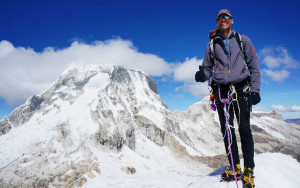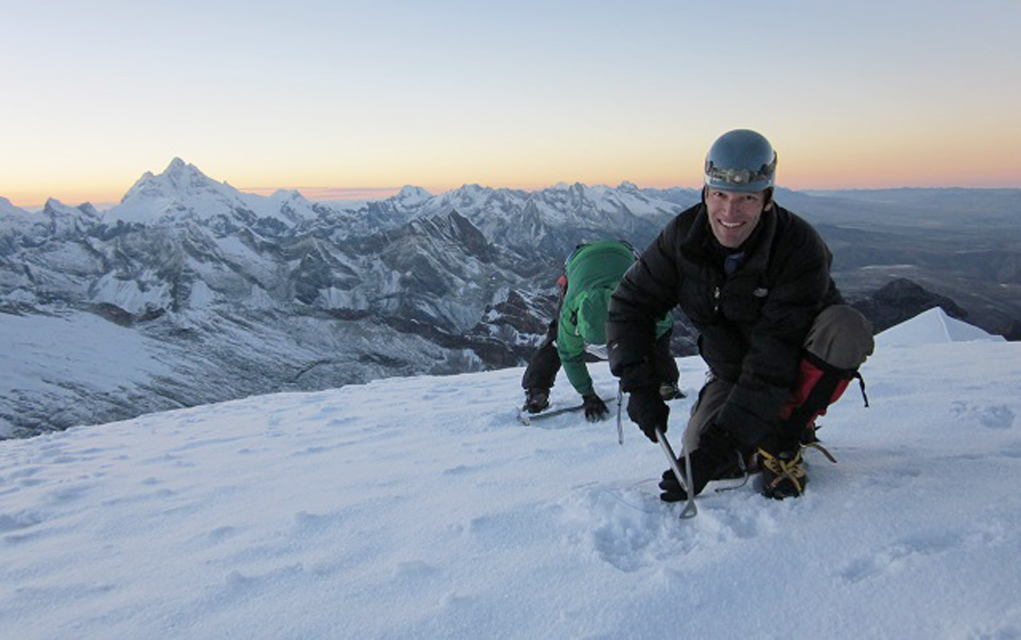
Blacker than the thoughts that lurk in the corners of your mind, tiny particles come to rest on the pristine face of secluded glaciers in the Andes Mountains. In the tropical sun, black carbon warms the snow and steals water from valley towns.
Black carbon consists of fine particles formed by burning fossil fuels, agricultural burning and wildfires. Scientists have been studying the effects of black carbon on glaciers all over the Northern Hemisphere for decades, but Southern Hemisphere research was limited to Antarctica, blackening South American glaciers with no one the wiser.
That is until Eldora scientist Carl Schmitt took a trip to the Cordillera Blanca tropical mountain range in the Andes of northern Peru. Most of us don’t think glaciers when we hear tropics, but for a sixth of the world’s population in South America, Africa and Indonesia, these glaciers are a major water source. The Andes are home to 98 percent of tropical glaciers.
Glacial melt provides drinking water, irrigates crops and generates hydropower. But since 1970, 40 percent of glacier surface area in Peru has melted away. Climate change causes most of it, but carbon in the atmosphere isn’t the only culprit.
Carbon dioxide can stay in the atmosphere for tens to hundreds of years, creating changes in the long-term weather patterns as a result of global warming. But some of it, black carbon, falls back to Earth in a matter of weeks, creating a separate issue. When it lands on glaciers, the ice begins absorbing sunlight, rather than reflecting it, speeding up the already dangerous melting rates.
“Black carbon is about as efficient at absorbing light as it is possible to be,” Schmitt says. “And it just takes little tiny specks.”

Although Schmitt works for National Center for Atmospheric Research (NCAR) in microphysics, he wasn’t looking at the effects of black carbon when he first traveled to Cordillera Blanca. He and his wife, Rebecca Cole, are both retired cross country ski racers, and they were looking for something to fill the void of outdoor activity left by racing days gone by.
Accordingly, Schmitt’s first trip to the Cordillera Blanca in 2010 was for a mountaineering course. The next year, Schmitt and Cole were invited on the Cordillera Blanca Environmental Expedition, a volunteer effort to gather scientific data from remote, high elevation mountains most scientists can’t reach.
“When I went down that first year it seemed like there was just a huge need for more information,” says Cole, Costa Rica native and tropical ecologist with the University of Hawaii at Manoa. “The resources that exist there are just, they’re not great.”
Schmitt and Cole founded the American Climber Science Program (ACSP) in 2011, with two other partners. Based in Eldora, the program focuses its efforts on research expeditions to conserve the unique environments of isolated mountains. Schmitt specifically focuses on determining whether black carbon is the reason tropical glaciers are melting faster than climate change alone can explain.

“I think it’s going to be somewhere on the order of 10 to 30 percent of snow being lost is due to the black carbon particles,” Schmitt says. “But that’s just a very rough educated guess.”
Millions of people around the world rely on glacial water, according to NCAR. But local governments don’t always have the resources or information they need to build new infrastructure or find new water sources.
“We’re basically trying to provide information so that the people in that area can better manage their resources and better adapt to climate change,” Cole says.
“We had a student two years ago who did interviews with the locals, and it’s really interesting, their perceptions of climate change,” Cole continues. “There was literally not a person that he talked with who didn’t say something like, ‘we’re not getting as much rain as we used to,’ or ‘the timing of the water flow is really different, so it’s difficult for us to grow our crops,’ or say that the water supply to their house has changed.”
One Peruvian town, Ollantaytambo, is rebuilding a centuries-old Inca canal to bring water into town. But that’s not an option everywhere, especially for big cities like Lima, the capital of Peru.
Lima, with a population of eight and a half million, is the second largest desert city in the world and it relies heavily on glaciers. Ideas for new water sources include expensive desalinization projects and digging a 120-mile tunnel to the Amazon.
“We’re not going to stop climate change, not in time to save these glaciers,” Schmitt says. “So they need to adapt their infrastructure and figure out what they need to do.”
In Cordillera Blanca, ACSP found that glaciers near Huaraz — where black carbon rises from pollution in the city and is deposited on surrounding glaciers — are more severely impacted on average than glaciers 50 miles north in Huascaran National Park. ACSP is planning expeditions next year to study the glaciers north of Lima that supply its water to see if they are similarly polluted as the glaciers 200 miles away in Cordillera Blanca. ACSP wants to find how much time is left before important glaciers are gone.

“Probably a 50 year time scale for some of the remote glaciers,” Cole says. “But we could be talking a 10 year time scale in areas where glaciers are being impacted by black carbon and melting much more quickly.”
Burning the Amazon rainforest to make room for crops, livestock and people and agricultural burning to clear land and improve soil are the biggest threats to South American glaciers. Other sources include industry, mining, diesel trucks and cook stove smoke. None of which would be as bad if it weren’t for lax pollution regulation by local government.
“There are pollution controls, but they’re not necessarily enforced,” Schmitt says. “I did a presentation in Huaraz, and a woman asked me a question, she said, ‘What do you think about the practice of burning tires? Is that a big source of black carbon?’ And I said, ‘Yeah I think it could be.’ She said, ‘Well it was outlawed five years ago, so they only do it at night now, so you can’t see the smoke.’”
ACSP is in their sixth year of taking volunteers and students into the field to sample snow, test water quality, study soils, measure vegetation and monitor wildlife. Through a grant from the U.S. Agency for International Development, ACSP also brings Peruvian students on expeditions so they can learn to study the glaciers in their own backyards.
“They live right next to this amazing national park and most of them had never had the opportunity to go into it,” Cole says. “They’d never been camping, and they don’t have any opportunities to do hands-on science.”
The mountains in Cordillera Blanca rise as much as 22,000 feet above sea level. Students in Huaraz look up at them everyday, but never go. Some had never even felt snow.
A day with the ACSP expedition could be anywhere from eight to 18 hours, hiking through valleys and climbing peaks over 20,000 feet. Each backpack of snow samples weighs 40 to 60 pounds at the end of the hike. All the snow must then be strained through filters the size a quarter to be packaged and shipped back to the U.S. for study.
More Peruvian students sign up every year, Schmitt says, and currently three students are working on independent projects studying black carbon and measuring air pollution.
ACSP is primarily funded by volunteers and Cole and Schmitt work on the project during their vacations, weekends and evenings on top of their daytime work. But Cole says it’s worth it.
“As scientists most of us get into the field because we want to make a difference. … A lot of times we end up doing research and writing papers and just kind of hoping that will have an impact, somebody will read it and decide to change something,” she says. “But it’s really gratifying to actually do something in a place where at the end of the day you can see the result. And that’s what I feel this is all about.”














